An excellent radar with more range than Garmin - but is Wahoo's new Trackr radar better?
Does Wahoo’s new radar unit comes close to matching the performance of Garmin’s venerable Varia units? I took it across France to find out.
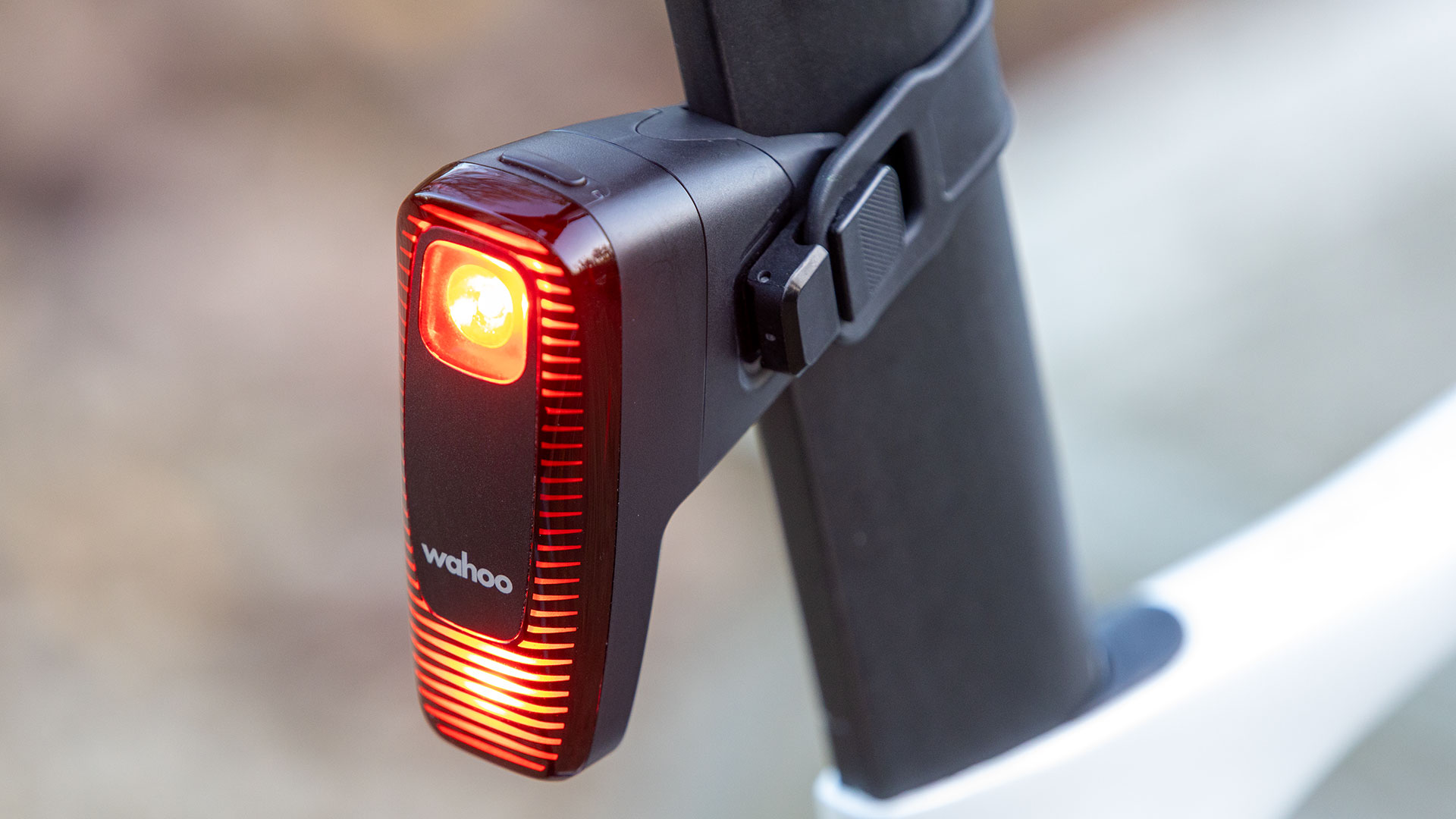
The Wahoo Trackr Radar is a stylish bike radar with some top-tier features, including dual LEDs, a superior range, and impressive battery life. It performs certain duties better than its main competitor, the Garmin Varia RTL 515, and a few slightly worse. Overall, though, it’s an excellent piece of equipment that should boost your riding confidence and safety.
-
+
Superb radar range under optimal conditions
-
+
Great connectivity with Wahoo computers, plus other brands too.
-
+
Dual LEDs are super visible, night or day
-
+
Unique additional features, such as the brake light
-
+
Good battery life
-
-
It has a narrower field of view than Garmin units
-
-
Slightly more expensive than the competition
You can trust Cycling Weekly.

I’ve been riding with radar for about five years now. Initially, when both of my brothers recommended early Garmin Varia units to me, I thought their suggestions were a lame joke, but I’ve since become a keen advocate. Recently, I’ve been trying to pare down the sheer amount of gear I take on my everyday rides, but I’ve found radar so effective it’s the one piece of kit I now feel uneasy leaving home without. So enamoured am I with this tech, I’ve even bought Garmin Varia RTL 515 radar units for my wife and two grown-up children.
So, when Wahoo entered the radar market with its Trackr Radar in the spring, launched alongside the new Roam 3 and the Bolt 3, I simply had to take a look.
Essentially, all bike radar systems emit a millimetre-wave radar signal from a small device mounted at the rear of the bike, which bounces off approaching vehicles behind the cyclist. A receiver in the unit detects these reflected signals to identify vehicles and calculate their distance and speed. This information is then transmitted wirelessly to a compatible head unit, such as a Garmin Edge or Wahoo Elemnt, which provides visual and audible alerts to the cyclist. Most radar devices, including the Trackr Radar, also serve as lights,
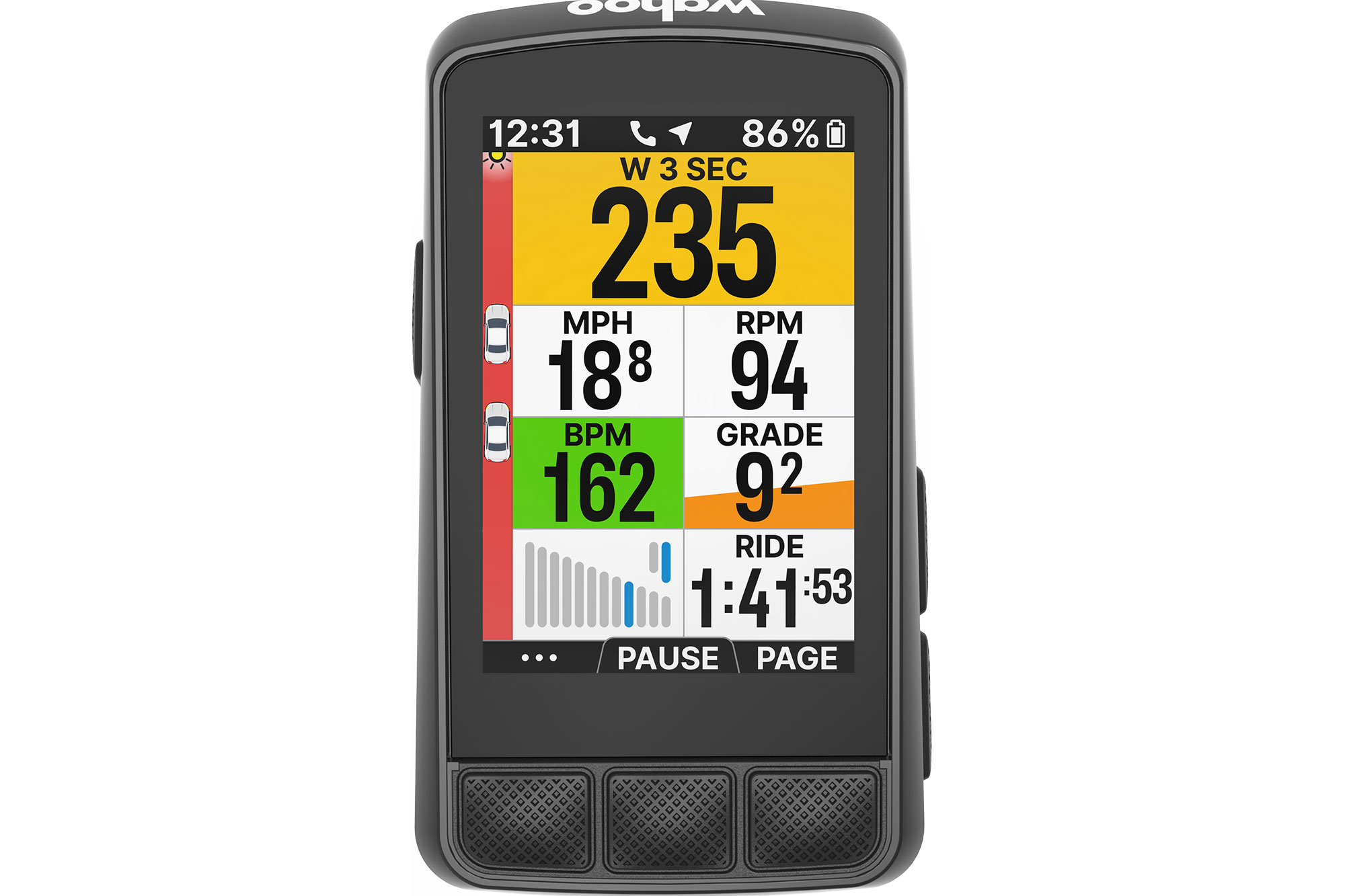
Vehicles detected up to 150m away are represented by small, movable icons that advance up a strip that appears at the edge of your head unit's screen.
Unfortunately, poorly executed bike radar devices can throw up false positives, warning of non-existent traffic, which is extremely irritating. Worse still, they can fail to report vehicles altogether, making them worse than useless. Dangerous even. Garmin’s Varia units have a fantastic track record in this regard, so I was excited to see whether the new Wahoo Trackr Radar could match, or even exceed, their performance.
The launch of the Trackr Radar coincided with an epic coast-to-coast ride across France I had planned with my brothers, giving all three of us ample opportunity to test sample units provided by Wahoo, alongside a trio of Roam 3 head units.
Construction
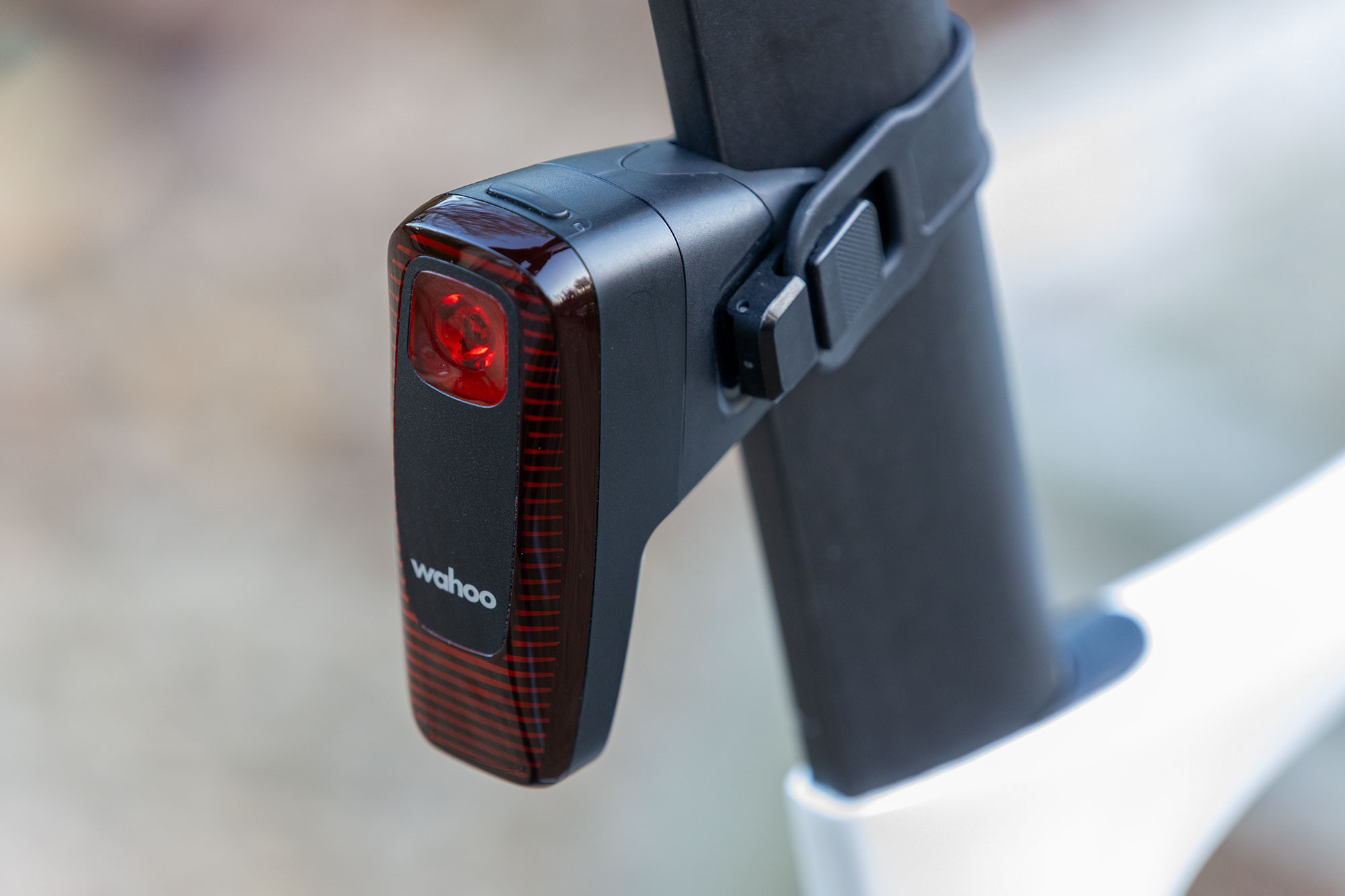
The Trackr Radar features two LEDs: a primary light at the top that can optionally be set to flash, and a secondary light that pulses continuously.
The Wahoo Trackr Radar is a sleek-looking device, that’s more organic in shape than the sharp-sided Varia units most of us are familiar with. In the hand, its smooth, rounded edges give it a pebble-like vibe.
It features dual LEDs, with a primary light at the top centre and a secondary light at the bottom centre, which also illuminates the sides of the device. The unit offers four distinct light modes, each with two brightness levels – high and low – for both steady (aka solid) and flashing outputs: high steady, low steady, high flash, and low flash. Regardless of the mode – steady or flashing – the lower light continually pulsates. Maximum output is 53 lumens in high flash mode, reducing to 10 lumens in low steady mode. Wahoo claims a battery life of 20 hours in low flash mode (18 lumens).
The latest race content, interviews, features, reviews and expert buying guides, direct to your inbox!

Configuring the radar on the Wahoo Elemnt Roam 3 is very simple.
Like many radar units, the Trackr Radar can be configured to flash continuously when it detects a vehicle, a mode Wahoo calls Quick Alert. Similarly, when Battery Extender Mode is enabled, output is reduced by up to 50 percent when no vehicles are detected, helping to save battery life. Alternatively, in Auto Light mode, the light defaults to off and only turns on when a car approaches. Uniquely, the Trackr Radar’s built-in accelerometer will trigger a bright, solid ‘brake light’ if you decelerate quickly.
Radar pickup range is excellent, with a claimed 150m (164 yards), outperforming the Garmin Varia RTL 515’s 140 metres (153 yards). However, its detection angle, or field of view (FOV), is narrower at 35 degrees compared to the Varia’s 40 degrees, a 13 percent difference.
The Trackr Radar connects to compatible cycling computers and smart watches, including non-Wahoo models, via ANT+. It also communicates with the Wahoo smartphone app over Bluetooth for firmware updates and light mode selection, but that’s all. The Wahoo app cannot be used during riding to detect vehicles.
Charging is via USB-C, which is convenient; Garmin still uses the older Micro-USB standard. The claimed weight, including mount, is 99g (3.5oz), which matches the reading on my scales. The unit ships with an aero-inspired, faired seat post mount, along with long and short adjustment straps and three rubberised wedges to ensure a secure fit on round, aero, and D-shaped posts.
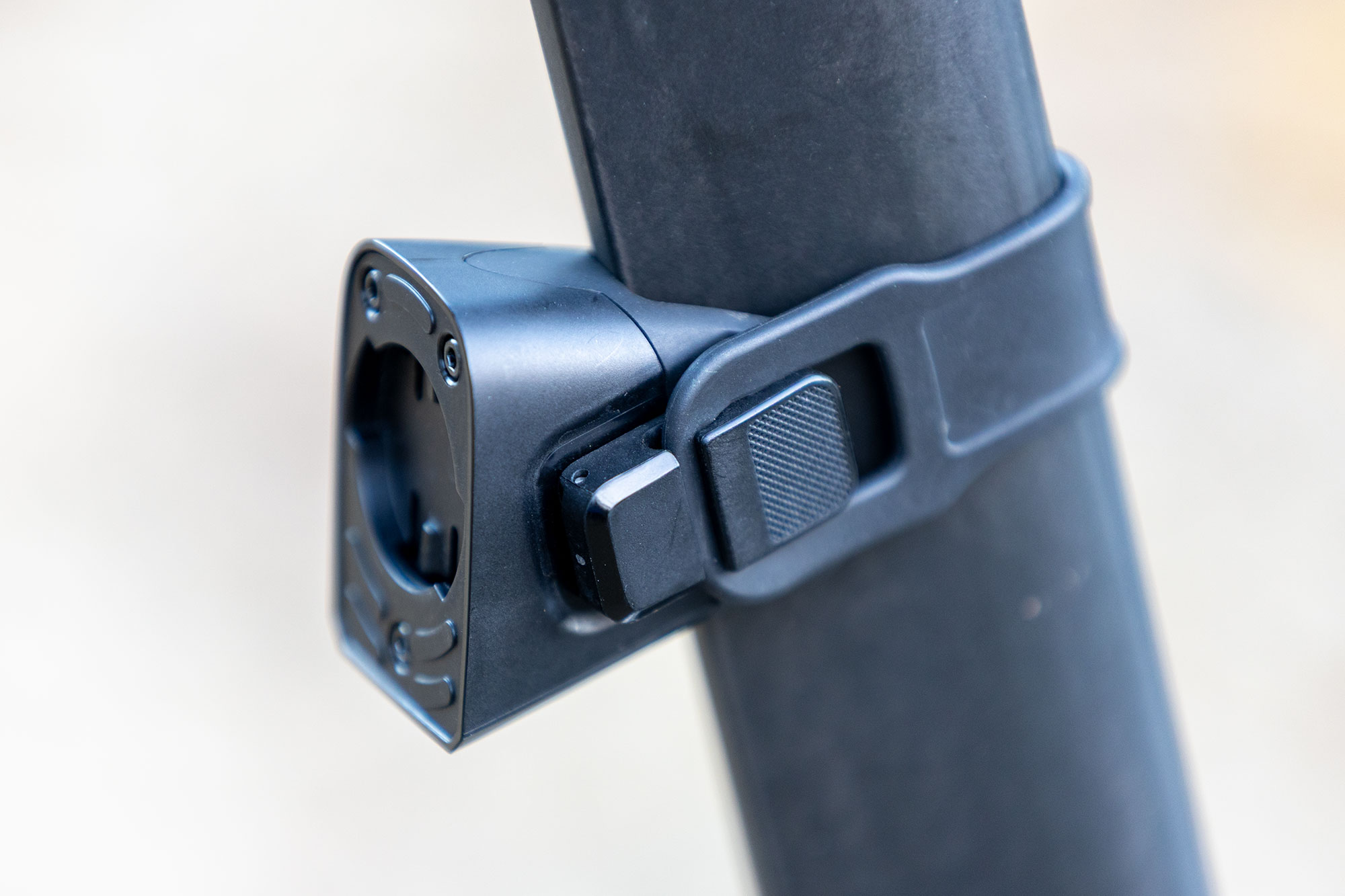
The aero-inspired mount will fit most seat posts, thanks to the inclusion of three rubber inserts that will conform to most post shapes.
The mount is a quarter-turn twist-fit, which may look very similar to Garmin’s standard, but annoyingly it’s not; there’s about a mm difference between the two. However, if you have existing Garmin mounts, it’s possible to repurpose them using replacement pucks available from Wahoo, Framesandgear, and KOM.
The ride
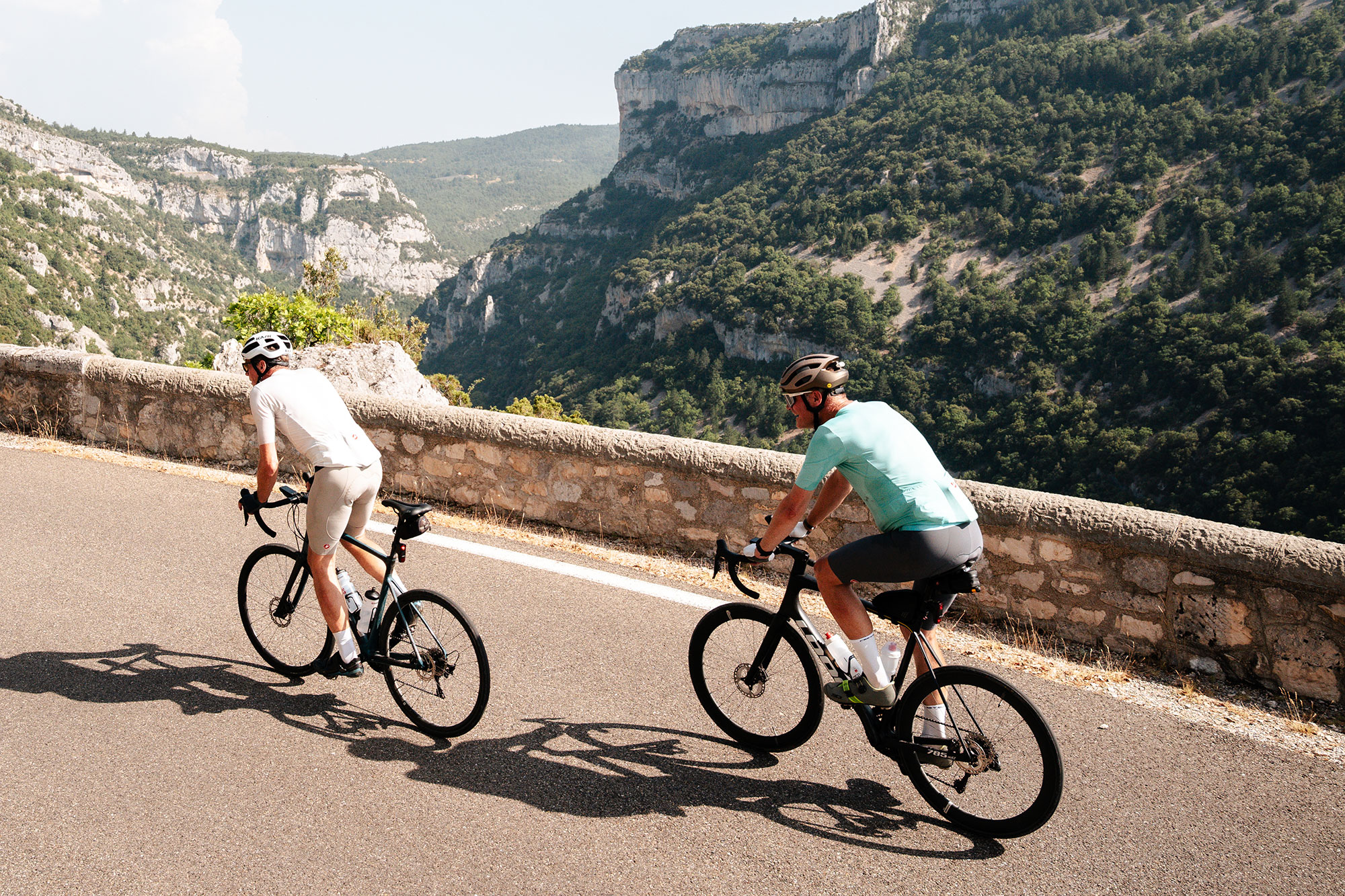
We found the units plenty bright enough, even in strong sunlight.
I found the initial setup very straightforward. It’s best practice to pair the radar with the Wahoo smartphone app first, to check for firmware updates, but you can skip this step if you’re in a hurry to get started. Connecting the Trackr Radar to my Wahoo Roam 3 was similarly smooth – it just works.
You can cycle through the four light modes by briefly pressing the single power on/off button at the top of the unit, but configuring the Trackr Radar via your head unit offers additional options, such as the Auto Light feature. For some unexplained reason, the brake light, quick alert mode and battery saver mode must be enabled through the Wahoo app, rather than via your head unit.
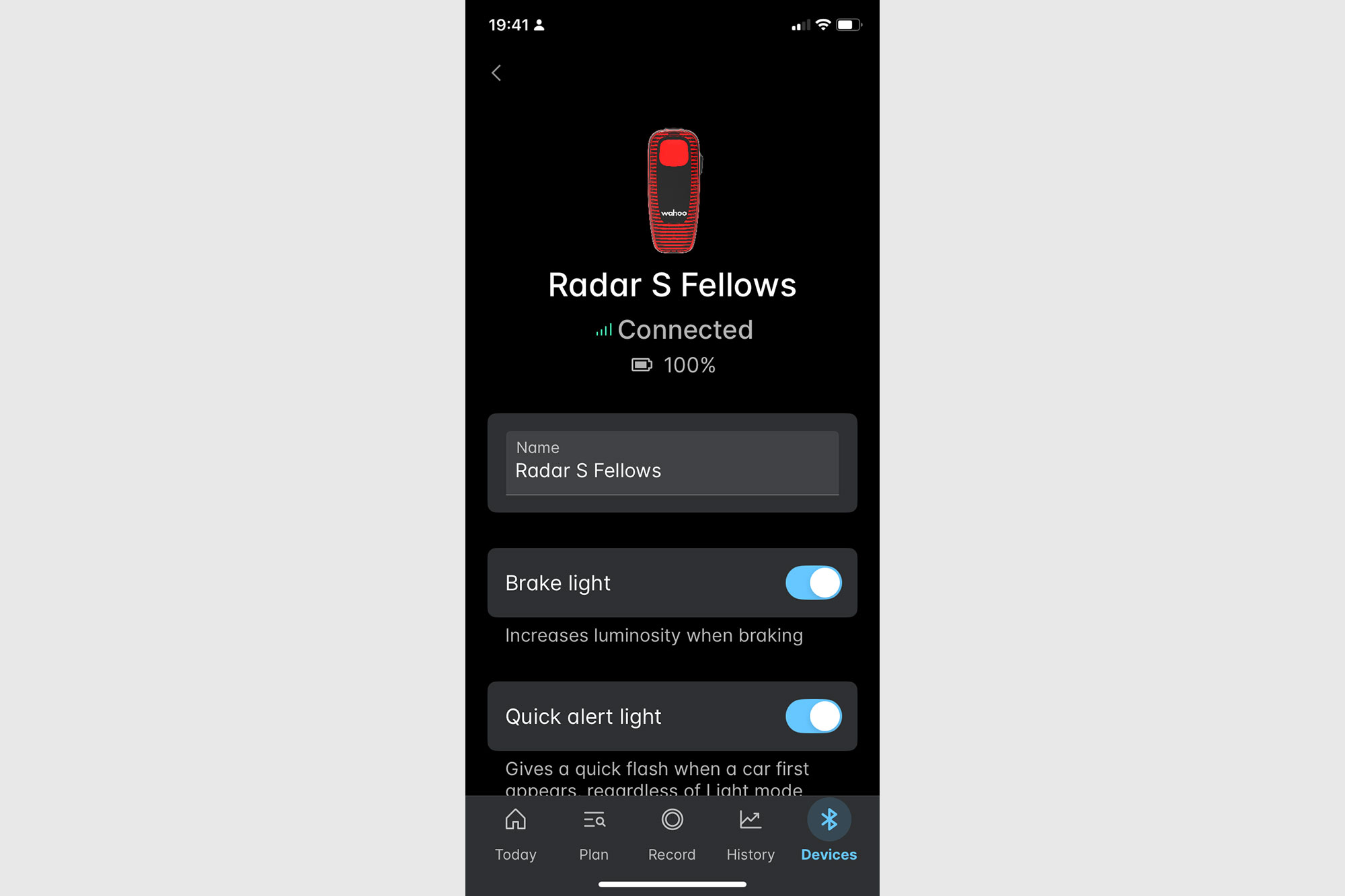
The Wahoo app, shown here on an iPhone screen, is for basic setup and firmware updates. Unlike Garmin's Varia smartphone app, it cannot be used during a ride to show the location of vehicles.
I also successfully connected my Wahoo Trackr Radar to various Garmin bike computers, including the Edge 1040 and 1050. The radar functionality worked as expected, but I had to control the lighting modes manually via the button on the radar unit. This meant I lost some additional light features, such as the brake light, Battery Extender mode, and others.
If you’ve used a radar system before, the way the Trackr Radar displays the presence of vehicles will be very familiar. Vehicles detected up to 150m away are represented by small, movable icons that advance up a strip that appears on the right or left-hand side of your head unit (the position is configurable in Wahoo and Garmin computers). As they get closer, they appear further up the strip until they eventually pass you. If you or they turn off onto another road, they’ll disappear from the strip.
A Wahoo headunit will flash red and give an audible alert if a vehicle is closing at a high rate of speed
The Wahoo system uses colour-coding to signal the threat level: the strip is typically green when the road is clear, changes to amber when a vehicle is approaching, and flashes red alongside an audible alert if a vehicle is closing at a high rate of speed.
Frankly, radar doesn’t eliminate the need to look over your shoulder when making critical manoeuvres, such as changing lanes in traffic, but it does allow you to continually assess traffic conditions. After initially dismissing this tech as a gimmick, I now believe it greatly improves my situational awareness, which, in turn, boosts my confidence and safety while riding. This is particularly true on fast, relatively empty country roads where potholes and debris must be constantly negotiated, and cars can appear unexpectedly from nowhere. It’s empowering to be able to ‘see’ them and plan evasive action if necessary before I even hear them.
Counter-intuitively, I find radar less useful in busy, heavily built-up areas, where my screen is always filled with slow-moving cars. Unfortunately, bike radar won’t detect vehicles travelling at the same speed as you and your bike because it operates using the Doppler effect, which won’t register anything that isn't actively approaching or moving away from your rear wheel.
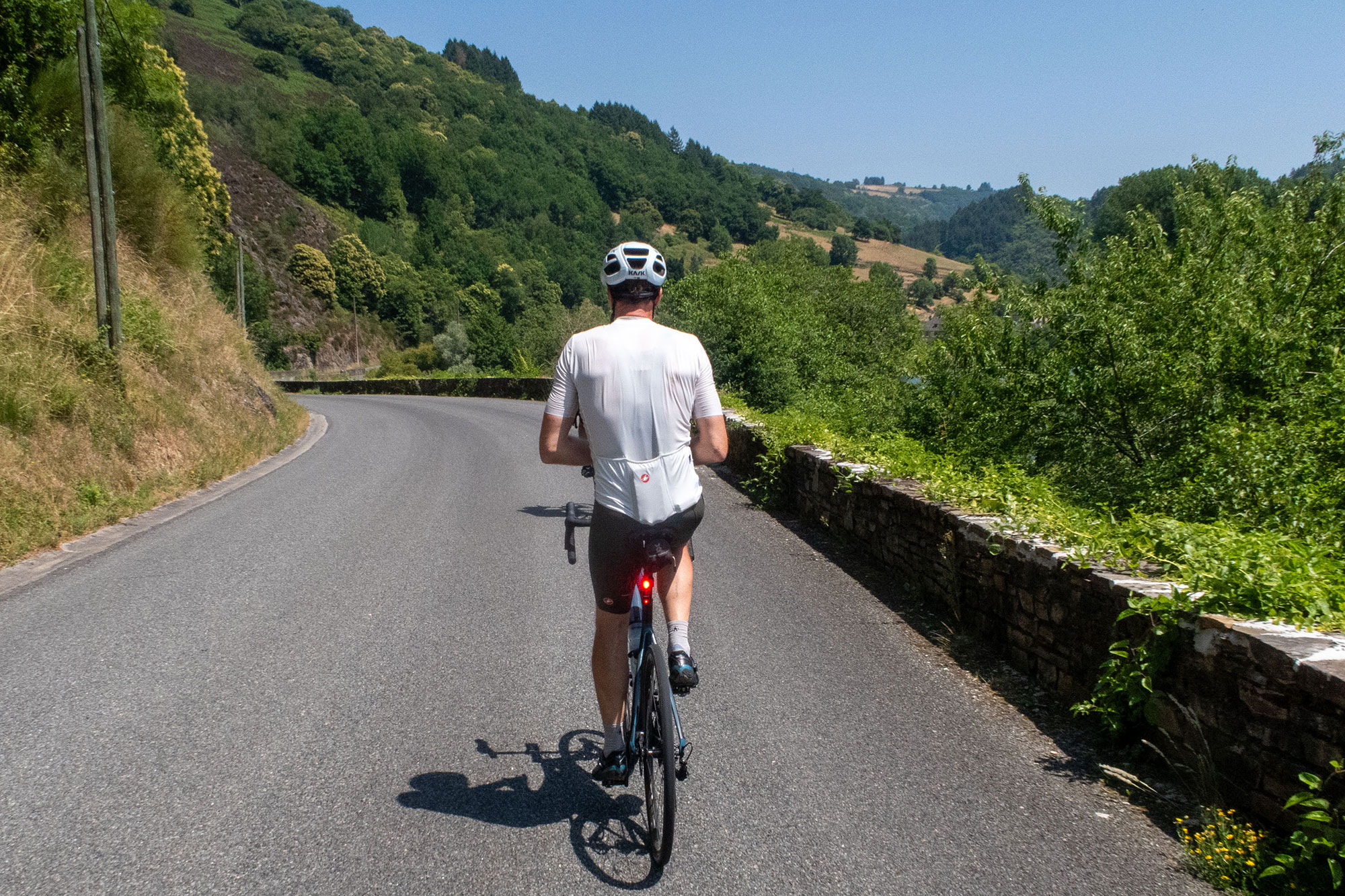
Radar can inspire confidence on the road.
The Wahoo Trackr Radar works remarkably well, with a few caveats. Firstly, during our ride through France, none of us experienced any false positives. None at all, which is impressive. Secondly, detection on long straight roads is excellent, comparable to, or even better than, Garmin’s Varia units. However, detection on very twisty roads or when riding in a group sometimes lags – occasionally, vehicles triggered our head units slightly later than expected.
The straight-line performance can be explained by Wahoo’s superior range, while our experience on the twisties, or when the Trackr Radar is temporarily blocked by a following rider, can be attributed to its slightly inferior field of view.
We used a variety of lighting modes during our ride, completely forgetting that flashing rear lights are now illegal in France. As the rider dropped most frequently by the group, I can confirm that visibility presented by the Wahoo Trackr Radar is superb. Even in bright daylight, I could see my ride buddies way off in the distance, at least 800 to 1,200 meters away.
The brake light is a nice touch, although we found it only triggered during sharp deceleration. Since the Trackr Radar’s accelerometer relies on detecting a significant change in speed, it won't illuminate the brake light when a rider coasts gently to a stop. However, its primary value is for sudden, hard braking, which is precisely when you need any following traffic to be alerted.
Battery life appears to be very good; we were putting in some long days in France, and I didn’t ever come close to exhausting the device. I tended to charge it every night, but my rough calculations suggest I could have got around 15 hours from it.
Value and Conclusions

The Wahoo Trackr Radar performed exceedingly well during our French coast-to-coast ride, with its performance only dropping marginally on twisty roads.
There are quite a number of inexpensive bike radar units on the market, but none offer the feature set of the Wahoo Trackr Radar. Its closest competitor is the Garmin Varia RTL 515, which, at £169.99/$199.99, is slightly cheaper than the £179/$249 Wahoo. However, the Wahoo has a more impressive radar range, features dual lights and has some unique features, such as the brake light. It also charges over USB-C, an upgrade we’re still waiting for from Garmin.
Its Achilles heel is its narrow field of view. My brothers and I all agree that, while the evidence is only anecdotal, it warns slightly later under some conditions than the Garmin Varia units we are used to. In every other area, its performance is exemplary, so I highly recommend it.
Specs
- Weight: 99g (3.5oz)
- Battery: Rechargeable Lithium Ion
- Battery Life: Over 10 hours
- Water Rating: IPX7
- Connectivity: ANT+ and up to three simultaneous Bluetooth connections. Third party ANT+ bike computers are supported but may not be compatible with all features.
- Radar sensitivity range: 150m (492 ft)
- Radar beam width: 35 degrees

Simon spent his childhood living just a stone’s throw from the foot of Box Hill, so it’s no surprise he acquired a passion for cycling from an early age. He’s still drawn to hilly places, having cycled, climbed or skied his way across the Alps, Pyrenees, Andes, Atlas Mountains and the Watkins range in the Arctic.
Simon now writes for Cycling Weekly as a freelancer, having previously served as Tech Editor. He’s also an advanced (RYT 500) yoga teacher, which further fuels his fascination for the relationship between performance and recovery.
He lives with Jo, his yoga teacher wife, in the heart of the Cotswolds, with two rescue cats, five bikes and way too many yoga mats. He still believes he could have been a contender if only chocolate weren’t so moreish.
You must confirm your public display name before commenting
Please logout and then login again, you will then be prompted to enter your display name.